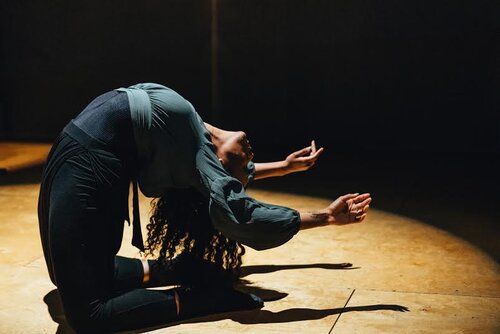And what was the relationship between Mann and Zaritt? One moment suggested tormentor and tormented: Zaritt, wearing an excruciatingly forced smile, splayed himself along a wall while Mann cackled creepily from a stool. But her tone would shift. “Jesse, what are you doing?” she asked, sounding confused and maternal. Zaritt scribbled on a piece of butcher paper; they dragged ropes around. After leading a chant that started, “At the moment the house is upside down,” Zaritt pranced out the door to a polka-like beat.
Lux Boreal, a six-dancer ensemble from Tijuana, Mexico, followed Mann and Zaritt on the second weekend of performances with La Ciudad Que Arde (The Burning Town), choreographed by Henry Torres Blanco. It was the festival’s most elaborate feature, with multiple costume changes and projections. It also had the most narrative contour, outlined in Spanish and English asides, seeming to comment on the technological gaze and apocalypse fetishism.
Leading much of the highly lyrical ensemble dancing was a performer who at first sat behind at a computer while lines of code appeared on the wall. Dancers emerged furtively from corners, crawled on their knees and collapsed, suggesting druggy submission, followed by passages of cross-hatching leaps and limp-armed languor. The motif of objectification surfaced as the coder-dancer hovered with a webcam over a soloing woman dancer.

I already wanted webcam man deposed when he tried to do something cruel with boiling water and ice cubes, and the piece’s climax obliged: He was forcibly disrobed, and the group reformed as equals in jumpsuits. But maybe the mutiny that felt like victory came too late? Lava and glacier imagery lit up the wall, and a nuclear mushroom erupted as a dancer flung a fistful of dust in the air.
Other artists located “tenderness” in allusions to healing and resilience: Enter: Light, a series of solos and duets by dana e. fitchett, derives its name from a Rumi line about recovering from trauma, while a projected quote noted African Americans’ long-denied “right to move." brontë velez’s meanwhile, the mud still mothers drew its choreography from the black feminist scholar Alexis Pauline Gumbs’ description of “mud mothers” in her book M Archive.
Navarrete, the festival’s co-curator, has close ties to artists incorporating activism into their practice; he works at Oakland social-justice hub East Side Arts Alliance. Fittingly, some of the performance programming broached topics that were then addressed more directly in events billed as “deep community engagement,” a range of participatory workshops led by local artist-activists such as poets Regina Evans and Tongo Eisen-Martin.
Owing to the dozens of artists involved in this “exchange” programming as well as the daily movement instruction, the three weeks of events at the 75-seat Joe Goode Annex had a familiar, easygoing atmosphere that perhaps realized tenderness more than any one piece. To wit, Brontez Purnell’s Tender Dub Remix, headlining the last weekend, began with audio of his mother sounding ambivalent about his birth. At the end, he served birthday cake to everyone present.
"dance" - Google News
January 28, 2020 at 06:45AM
https://ift.tt/2tXL1j3
Fresh Festival Remains a Bastion of Dance Experimentation - KQED
"dance" - Google News
https://ift.tt/33ygDYM
No comments:
Post a Comment